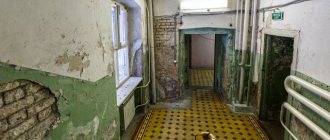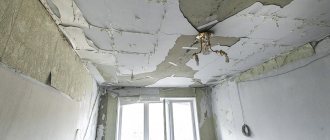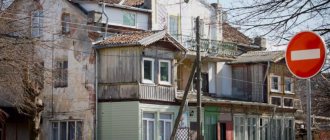Home / Real estate / Housing rights
Back
Published: 09/21/2016
Reading time: 9 min
0
3587
One of the old, but still relevant Russian problems is dilapidated houses. This problem is closely intertwined with the housing issue in general. And taking into account the latest government instructions on the resettlement of residents of emergency housing, the problem has become even more urgent.
In our article we will shed light on the problems associated with dilapidated houses, as well as the rights that residents of such houses have. We will separately consider the issue of the demolition of such buildings and compensation for housing, the timing and process of moving, as well as the privatization of housing in such cases.
- When is it possible to demolish a house and what rights do citizens have?
- When does housing fall into the emergency category?
- What will the residents of a privatized apartment receive if the house is demolished? Collect the purchase price of the home
- Obtaining equivalent living space
When is it possible to demolish a house and what rights do citizens have?
Eviction of citizens from a dilapidated house is applicable only in exceptional cases, which are provided for by the legislation of the Russian Federation.
The main goal envisaged by the eviction of citizens from their homes is the release of residential premises, which are in an emergency situation, in order to avoid the collapse of the house and accidental victims.
In practice, those citizens who live in brick houses whose wear and tear is more than 70% or 65% in the case of attics and wooden houses are subject to eviction. This percentage value is purely approximate, due to the fact that the legislation does not provide a formula for calculating the percentage of accidents at home.
Demolition of an unsafe or dilapidated house is possible in two cases:
- It is planned by the state program.
- Residents turned to the housing commission and asked for an examination and further demolition.
In practice, it is mainly barracks and old multi-storey buildings that were built in the last century that are subject to demolition.
The legislation clarifies that housing is not subject to demolition in the following cases:
- Multi-storey buildings (five or more) that do not have a garbage chute and an elevator are inoperable and cannot be reconstructed.
- Lack of centralized hot water supply or sewerage in one- and two-story buildings.
- If the housing does not comply with current housing standards, but was built before the adoption of the necessary regulations, but at the same time complies with ergonomic standards and allows the placement of furniture and other property.
It is important to know that eviction will not help improve the living conditions of the residents, because the number of square meters in the new housing will be the same as the old one.
You also need to take into account that you will not always get “new” housing in a new building; in practice, residents of unsafe and dilapidated houses are most often relocated to “secondary” type housing.
The current legislation does not have a time limit within which a dilapidated or dilapidated house will be demolished, and the residents of this house must receive new living quarters. Demolition deadlines are set by the municipal authorities and are subject to change.
The resettlement does not provide any benefits for certain segments of the population; there is only one general queue. But beneficiaries can count on additional square meters.
Having received a “new” home, you need to make sure that the redemption price for it corresponds to the expected one and that the apartment itself meets the standards of the country’s housing legislation. Otherwise, you should go to court to protect your rights. In such claims, the court most often takes the side of the victims.
Arbitrage practice
Tired of the promises and inaction of the authorities, residents can defend their rights in court. This usually happens if the house is not recognized as unsafe. The authorities may persist and not include the house on the list for resettlement. If the housing is in disrepair in all respects, and housing supervision is in no hurry to admit this, the only way out is to file a claim for the inaction of the authorities.
Example:
The court considered the claim of Yu.V. Kolokolnikov regarding the inaction of the Serpukhov administration. The plaintiff explained that he owns a private (individual) house within the city. The building was built in the 40s of the last century, and since then has seriously deteriorated. The plaintiff tried to make repairs, but there was no effect due to the unsuitability of the foundation and supporting parts of the building. Kolokoltsev appealed to the local administration of Serpukhov with a request to recognize the house as unsafe and subject to demolition. From there, the plaintiff received a refusal with the motivation - the property is private, not multi-apartment, the commission does not consider such housing. The plaintiff asks the court to oblige municipal authorities to inspect a private house based on an application from the owner. The court studied the case materials and granted the plaintiff's request. Explanation of the court decision - according to the law, the procedure for inspecting residential buildings for their damage and demolition provides for the work of an interdepartmental commission. According to Regulation No. 47 of January 28, 2006, no other procedure is provided for buildings in rural areas. The administration of the Moscow Region of Serpukhov is obliged to attract a commission to inspect the house. Refusal to take such action is unreasonable and illegal.
(Review of judicial practice approved by the Presidium of the Supreme Court of the Russian Federation on April 29, 2014)
Can residents count on their housing being recognized as unsafe? Practice shows that this is not always the case. The list of uninhabitable houses includes hundreds of properties in each region. The authorities simply do not have time, and often do not want to recognize the housing as subject to demolition. What should owners do? Residents will have to take care of their future themselves. This requires knowledge, legal experience and calculation of the consequences.
Contact the lawyers on our website and you will find out about a solution to your situation. The lawyer will tell you where to file a complaint, whether the house is considered unsafe, what they will give in return, and whether it is worth going to court? Responding to an acute situation will prevent disaster and loss of housing.
Watch a video about the problems with recognizing housing as unsafe and unfit for human habitation:
Attention!
- Due to frequent changes in legislation, information sometimes becomes outdated faster than we can update it on the website.
- All cases are very individual and depend on many factors. Basic information does not guarantee a solution to your specific problems.
That's why FREE expert consultants work for you around the clock!
- via the form (below), or via online chat
- Call the hotline:
- Moscow and the Region
- St. Petersburg and region
- FREE for a lawyer!
By submitting data you agree to the Consent to PD Processing, PD Processing Policy and User Agreement.
Anonymously
Information about you will not be disclosed
Fast
Fill out the form and a lawyer will contact you within 5 minutes
Tell your friends
Rate ( 1 ratings, average: 5.00 out of 5)
Author of the article
Maxim Privalov
Lawyer. 2 years of experience. I specialize in civil disputes in the field of housing and family law.
Author's rating
Articles written
610
When does housing fall into the emergency category?
Housing can be recognized as subject to demolition, reconstruction or emergency if it meets the standards approved by the government:
- If the building's foundation, load-bearing structures, walls have been damaged, as well as in case of noticeable biological damage, which indicates a threat of building collapse.
- If residential apartment buildings have previously suffered serious damage as a result of man-made disasters, natural disasters or fires, or if there is damage to load-bearing structures that cannot be restored or is not economically viable to repair.
- If housing is at constant risk due to the climatic conditions of the region (landslides, mudflows, avalanches, floods, etc.).
- If the house is located in a place of possible destruction in the event of a man-made accident (except for those cases where possible destruction can be prevented).
Also, your home may be considered subject to demolition in the following cases:
- If the windows face the highway, and the noise level exceeds all permissible standards and values.
- When a residential building is located in a place of constant exposure to harmful factors of various nature (chemical, industrial or biological), taking into account the impossibility of eliminating the risk.
- If there is a waste disposal facility or overhead AC power lines near your residence.
It is worth considering that most often those citizens who actually live in places with a constant risk to life and health are subject to resettlement.
Official recognition of the house as unsafe
In accordance with the legislative norms and acts of Russia, a house can be recognized as unsafe and subject to resettlement only after it has been officially recognized as dangerous to the life and health of residents.
Multi-apartment residential buildings are officially recognized as uninhabitable and are sent for demolition if the following conditions are met:
- dilapidated buildings in which the frame structure may spontaneously collapse;
- buildings located on or near landfills;
- buildings located in hazardous areas;
- buildings located in the power transmission line zone;
- destroyed completely or partially;
- buildings with excessive noise levels, for example, houses with windows facing the highway;
- buildings above which the garbage chute is located.
These categories of houses are officially recognized as unsuitable for habitation, and a state act is drawn up about this. After drawing up the act, the owners or social tenants of the premises can begin the procedure aimed at obtaining comfortable living space.
What will the residents of a privatized apartment receive if the house is demolished?
Residents of privatized housing have two options for further developments:
Collect the purchase price of the home
An appropriate agreement is concluded, which spells out all the details and nuances.
The purchase price of housing, according to the contract, includes not only the cost of the apartment itself, but also the costs of purchasing a new home as a whole (including the cost of moving), as well as lost profits (if the apartment was previously rented out). The contract may stipulate that the owner of the old emergency home will receive a new apartment in exchange for the redemption price of the housing. For a more accurate assessment of the redemption value, it is worth contacting professionals from appraisal companies.
Obtaining equivalent living space
According to the law, “new” housing must have the same number of square meters and rooms as the old one, and also have the same level of amenities and be located in the same area as the house that is to be demolished.
It is interesting that in the legislation, with an equivalent area of provided housing, we are talking about the total area of the apartment, and not about the living area. This is a significant disadvantage, because the “new” apartment may have a large storage room or corridor, which the citizen has no use for, and the area of the provided apartment will be the same as the old one.
What does the legislation say?
The main legislative act that operates in the country is the Housing Code of the Russian Federation. On its basis, various programs are made, acts and regulations are drawn up, according to which problems related to the resettlement of residents of dangerous houses are solved.
Resettlement is carried out in accordance with Government Decree No. 47, as well as Federal Law No. 185. Article 32 of the RF Housing Code establishes that homeowners living in a dilapidated building may demand compensation for losses and a refund for uninhabitable real estate.
If housing is not privatized
Residents of non-privatized housing have two other options:
- Try to privatize the apartment. Despite the absence of prohibitions on the privatization of such housing, in practice the housing department of the municipal administration often refuses to register housing that is subject to demolition.
- Residents are provided with new living quarters, which are equivalent to emergency ones.
It is important to know that if you lived in isolated housing, you cannot be provided with rooms in a communal apartment.
Dilapidated or in disrepair - what's the difference?
The Housing Code does not define the concept of “dilapidated housing,” but this term is quite widely used in practice. The interpretation of the concept of “dilapidated housing” is mentioned in the methodological recommendations for the maintenance and repair of housing stock. According to this document (which is not official), “dilapidated condition” is the condition of a residential premises when the wear and tear of the building structure is:
- over 70% (for a stone structure),
- over 65% (for wooden.
Photo by Pexels
Although dilapidated housing is characterized by a fairly high degree of wear and tear, there is no danger of collapse for such buildings. Therefore, even if the deterioration of the structure is more than 70%, this is not a guarantee that the dilapidated housing will be resettled. The decision on resettlement is made by an interdepartmental commission.
The condition of a building is considered emergency when more than half of the residential premises and main load-bearing structures of the building are classified as emergency and may pose a danger to human life.
Thus, the difference between emergency housing and dilapidated housing is that emergency housing has such deformations that can lead to collapse, therefore living in such a room is life-threatening.
The resettlement of emergency housing is similar to the resettlement of dilapidated housing.
Moving dates and procedure
The timing and procedure for moving residents of dilapidated houses to new housing is determined by municipal authorities in each specific region.
After the interdepartmental commission has completed its work and made a decision to recognize the house as unsafe or dilapidated, the municipal authorities issue an order to put the house on the demolition queue. The queue itself is formed in each individual region.
From this moment on, the authorized bodies are searching for appropriate housing for residents and relocating them. This can take several months or several years, depending on the efficiency of officials, the condition of the house (priority) and the availability of housing that meets the standards on the real estate market or in the housing reserve.
Find out from us how to rent an apartment through an agency correctly and without problems in the future. Extract from the house register - why is it needed and where can I get it? Find out about it in our article! Lifetime rent of an apartment is perfectly described in our material at the link!
Which one can they recognize and which one can’t?
The grounds for recognizing a residential building as unsafe are as follows:
- Deteriorated performance characteristics of the building and its parts due to physical wear and tear during operation. All this leads to the fact that the level of reliability of the structure is reduced, and the strength and stability of the building foundations are in question.
- Dangerous location of the house in an emergency zone (frequent landslides, avalanches). This should also include those structures that are flooded every year with flood water. It is impossible to foresee a possible cataclysm or use design and engineering solutions.
- The presence of damage to the building that was received as a result of an accident, explosion, fire, earthquake, soil subsidence and other complex geological phenomena. If restoration work fails, the technical condition of such houses may be characterized by a decrease in load-bearing capacity and operating characteristics. In this case, there is always a danger that people will live in unsafe conditions, and engineering equipment may fail.
- Presence of deformations in walls, foundations, supporting structures. This includes damage to wooden and brick houses, which confirm poor load-bearing capacity and the danger of collapse.
- The location of the house in the zone , which is determined by the federal executive authority in the event of a man-made accident.
Houses that are not in disrepair have no signs of damage and are considered favorable for housing.
Prospects for owners
What the owners should do if the house is declared unsafe is decided taking into account the proposed conditions. The presence of such status does not in any way affect the right to dispose of property. The apartment, as before, can be:
- sell;
- to rent;
- give as a gift or inheritance;
- register as collateral to obtain a loan.
However, you need to remember about the drop in cost due to the precise determination of the unsuitability of a property for habitation. It cannot be sold after signing an agreement with the local administration. Changes in ownership rights are limited to a special entry in the Rosreestr database.
Settlement
The owner has the right to receive real estate with equal or better consumer parameters. It is unacceptable to move into a communal apartment from an ordinary apartment.
Individual municipalities organize house relocation in cooperation with commercial organizations. The developer, after demolition, uses the land for planned construction. “Old” owners are offered apartments in new buildings with a better layout (larger area) to speed up business processes.
The procedure for relocating dilapidated and emergency housing is chosen by each region independently. General includes:
- Formation by the housing department of the administration of a list of citizens subject to relocation.
- Sending relocation proposals to citizens.
- Signing agreements on the seizure of an emergency apartment and the transfer of ownership of a new apartment.
- Registration of owners' rights in the Unified State Register of Real Estate.
The administration prepares all agreements independently.
Important! For the specific procedure for relocating your house, see the decision by which the house was declared unsafe. You can clarify controversial points regarding the procedure by calling the housing department.
Buying an apartment
If a house is declared unsafe, according to current legislation, the municipality has the right to use a buyout instead of resettlement. In this case, the calculation is made at tariffs corresponding to the cadastral value of similar real estate objects. As a rule, the cost price is less than market indicators. However, if the owner objects, forced eviction by court decision cannot be ruled out.
Read more about calculating and challenging the redemption price here.
Features of relocation from emergency buildings
To effectively resettle citizens in the regions, databases are being created that record information about dilapidated and emergency residential properties. Regional resettlement programs are developed taking into account federal regulations, such as. The document determines the dynamics of development of the housing sector in Russia.
Many citizens believe that they will definitely be provided with improved housing. However, the conditions must be at least equivalent to those in the emergency room.
Recently, “wave migration” has been occurring. This phenomenon does not affect all houses. The essence of the idea: apartment buildings for residents of dilapidated buildings will be built using budgetary and investment funds, and comprehensive development will begin on the vacated land.
If citizens do not agree to resettlement and refuse monetary compensation, forced eviction is provided with the provision of temporary housing from the regional or municipal fund.









